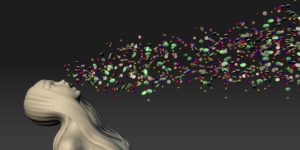National ADHD Epidemic

The CDC published a study that found 11% of school-aged children in the U.S. between 2003 and 2011 had received an ADHD diagnosis. This statistic meant that 6.4 million children, 1 in 5 boys and 1 in 11 girls, were said to have ADHD. A different CDC report indicated the American Psychiatric Association (APA) estimated in their 2013 edition of the DSM, the DSM-5, that only 5% of children have ADHD. The rates of ADHD diagnosis are increasing over time, from an average of 3% per year between 1997 and 2006, to 5% between 2003 and 2011. The prevalence of children between the ages of 4 and 17 diagnosed with ADHD varied widely by state. In 2011, the lowest reported rates were in Nevada (5.6%); the highest rates were in Kentucky (18.7%). In contrast, the percentage of children diagnosed and medicated for ADHD in France is less than half of one percent—.5%!
You can see the CDC reports cited above here, here and here.
Writing for Psychology Today in 2012, Marilyn Wedge noted in “Why French Kids Don’t Have ADHD,” how the difference seemed to turn on how ADHD was conceived. In the U.S. ADHD is seen as a biological disorder with biological causes. So the go-to treatment method is stimulant medications. Dr. Wedge also pointed that French psychiatrists did not use the DSM system to diagnose childhood emotional problems. Instead they used an alternative classification system that focuses on the underlying psychosocial causes of a child’s symptoms.
French child psychiatrists, on the other hand, view ADHD as a medical condition that has psycho-social and situational causes. Instead of treating a child’s focusing and behavioral problems with drugs, French doctors prefer to look for the underlying issue that is causing the child distress—not in the child’s brain but in the child’s social context. They then choose to treat the underlying social context problem with psychotherapy or family counseling. This is a very different way of seeing things from the American tendency to attribute all symptoms to a biological dysfunction such as a chemical imbalance in the child’s brain.
She commented that the holistic, psychosocial approach of the French allowed for the possibility there could be nutritional factors that worsen ADHD symptoms. “In the U.S., the strict focus on pharmaceutical treatment of ADHD, however, encourages clinicians to ignore the influence of dietary factors on children’s behavior.”
Psychiatrist Robert Berezin commented on Wedge’s report saying that it seemed American boys had contracted some contagion that spread ADHD exponentially. More seriously, he went right to the heart of the problem: if ADHD rates are so drastically different between the U.S. and France, how can ADHD be a brain disease? “Yes there can be symptoms of hyperactivity and concentration. But it is created by psychosocial causes, not biological ones. And the treatments should be appropriate to the cause.” He concluded that the French situation showed that so-called ADHD was a psychosocial problem, not a brain disease.
So if we accept this conclusion, where does this leave us in America with regard to ADHD and the aftermath of decades of conceiving and treating it as a brain disease? A recent investigative report by the Milwaukee Journal Sentinel and MedPage Today pointed out several areas of concern. First is the increase in the diagnosis of Adult ADHD. Twenty years ago ADHD was rarely diagnosed in adult Americans. Now, 1 in 23 adult Americans, around 10 million people, are said to have ADHD. And there has been a fourfold increase among adults 26 and older who use Adderall recreationally.
The reporters cited a 2010 study where 22% of the adults tested for ADHD had exaggerated their symptoms. This finding underscores how college-aged adults increasingly use ADHD medications as “study aides.” A 2013 study found wastewater samples collected near college dormitories in Tacoma Washington were eight times higher for amphetamines during final exams week than during the first week of classes. Although FDA adverse events indicated there were more reports for children, the adults were reporting more serious adverse events. “Adults accounted for just over one-third of reports, but made up more than half of all hospitalizations and 85% of deaths.”
Experts question whether adult ADHD is truly a widespread condition that needs treatment with the array of FDA-approved prescription medications. A medical historian, Nicolas Rasmussen, was quoted as saying that amphetamines are grossly overused; and that “the streets are awash with Adderall.”
Drug companies counter that ADHD is a real and treatable medical condition that effects millions of Americans. Charles Catalano, a spokesperson for Shire, which manufactures two ADHD medications, Vyvanse and Adderall, said the drugs have been approved by regulators around the world and are safe to use. “Our medications are proven to be effective when used according to prescribing practices of a licensed, trained health care professional.” A spokesperson for Novartis, the manufacturer of Ritalin, said it has been used safely and effectively for more than 60 years. “If used inappropriately, the results could be serious, just like with the misuse of any other medication.”
The DSM-5, published in 2013 by the APA, relaxed the criteria for diagnosing adult ADHD. Previously adults needed to have six of nine possible symptoms. Now they only need five of nine symptoms. Seventy-eight percent of the panel of experts who approved the changes had financial ties to drug companies. The APA minimized the potential conflicts of interest by stating no panel member had made more than $10,000 a year working as industry speakers and consultants.
Moffitt et al. published the results of a forty-year study of individuals in New Zealand in The American Journal of Psychiatry. The study found that found 90% of adult ADHD cases did not have a history of childhood ADHD. “The findings raise the possibility that adults presenting with the ADHD symptom picture may not have a childhood-onset neurodevelopmental disorder.” The authors added that if the findings were replicated, adult ADHD’s place in the DSM should be reconsidered and that research needs to investigate the etiology of adult ADHD.
It also appears that using ADHD medication leads to addiction and abuse problems with some individuals. Some of this is simple common sense. All ADHD stimulant medications are Schedule II controlled substances, meaning that the DEA considers them to have the same addictive potential as cocaine. Yet the research literature presents conflicting accounts. Some studies report that untreated ADHD is a significant risk factor in developing substance use disorders. Others suggest there is no compelling evidence that treating children with ADHD medication leads to an increased risk of later substance use problems.
A Medscape article concluded that the bulk of evidence suggested that treating ADHD with stimulant medication did not increase the risk for developing a substance use disorder, nor did it decrease to risk. At the very end of the article this comment appeared: “This activity is supported by an independent educational grant from Shire.” The author of the article had also received grants and served as a paid consultant for Shire.
On the other hand, Peter Breggin and others have noted there is a high abuse liability with stimulant medications. A 1995 DEA report indicated there was an abundance of scientific literature on the abuse potential of Ritalin and other Schedule II stimulants. A 1998 NIH conference on the “Diagnosis and Treatment of ADHD” stated: “An extensive scientific literature spanning more than 30 years of research unequivocally indicates that MPH [Ritalin] has a high abuse liability.” A 1995 study by Nora Volkow and others found that cocaine and MPH had similar effects on the brain when given intravenously. Breggin commented in his discussion of the study in his book, The Ritalin Fact Book, that the main difference was the longer lasting effect of Ritalin. This was speculated to be why Ritalin was less subject to abuse than cocaine. Breggin said:
What does all of this mean in plain English? Ritalin’s biochemical mechanism of action is essentially the same as that of cocaine, and therefore Ritalin produces similar effects to cocaine. In fact, all of the stimulants, including Ritalin and cocaine, jack up dopamine, serotonin, and norepinephrine chemical messengers in the brain, producing a variety of similar mental abnormalities. If given intravenously, the “high” is the same for all of them.
A study by Schrantee et al. published in the September issue of JAMA Psychiatry found there was a distinct effect of methylphenidate (Ritalin) on the brains of children and young adults. A discussion of this study in an article on Mad in America indicated the lead researcher of the study’s team, Liesbeth Reneman, said given that maturation of several brain regions are not complete until adolescence, drugs given during the sensitive, early phases of life could effect “neurodevelopmental trajectories” and have profound effects later in life.
The adolescent brain is a rapidly developing system that maintains high levels of plasticity. As such, the brain may be particularly vulnerable to drugs that interfere with these processes or modify the specific transmitter systems involved.
The mesolimbic dopamine system (MDS), the reward pathway of the brain, is one of those later maturing brain regions. Incidentally, the MDS is probably the region of the brain where drugs produce dependence. In his book, The Science of Addiction, Carleton Erickson said neuroscientists believe that when the functioning of certain MDS neurotransmitter systems are disrupted from genetic “miswiring” and/or long-term exposure to a drug, “chemical dependence as a brain disease” can develop.
The Schrantee et al. study is the first evidence that using ADHD medications can alter brain development. So studies of the long-term consequences need to be completed. But one of the questions that should be investigated is does the long-term use of stimulant medications effect changes to the MDS of the brains of adolescents and young adults and are those changes related to a greater risk of substance abuse. Hopefully we’ll have some answers before prescription stimulant drugs compete with opioids as a national drug epidemic.

